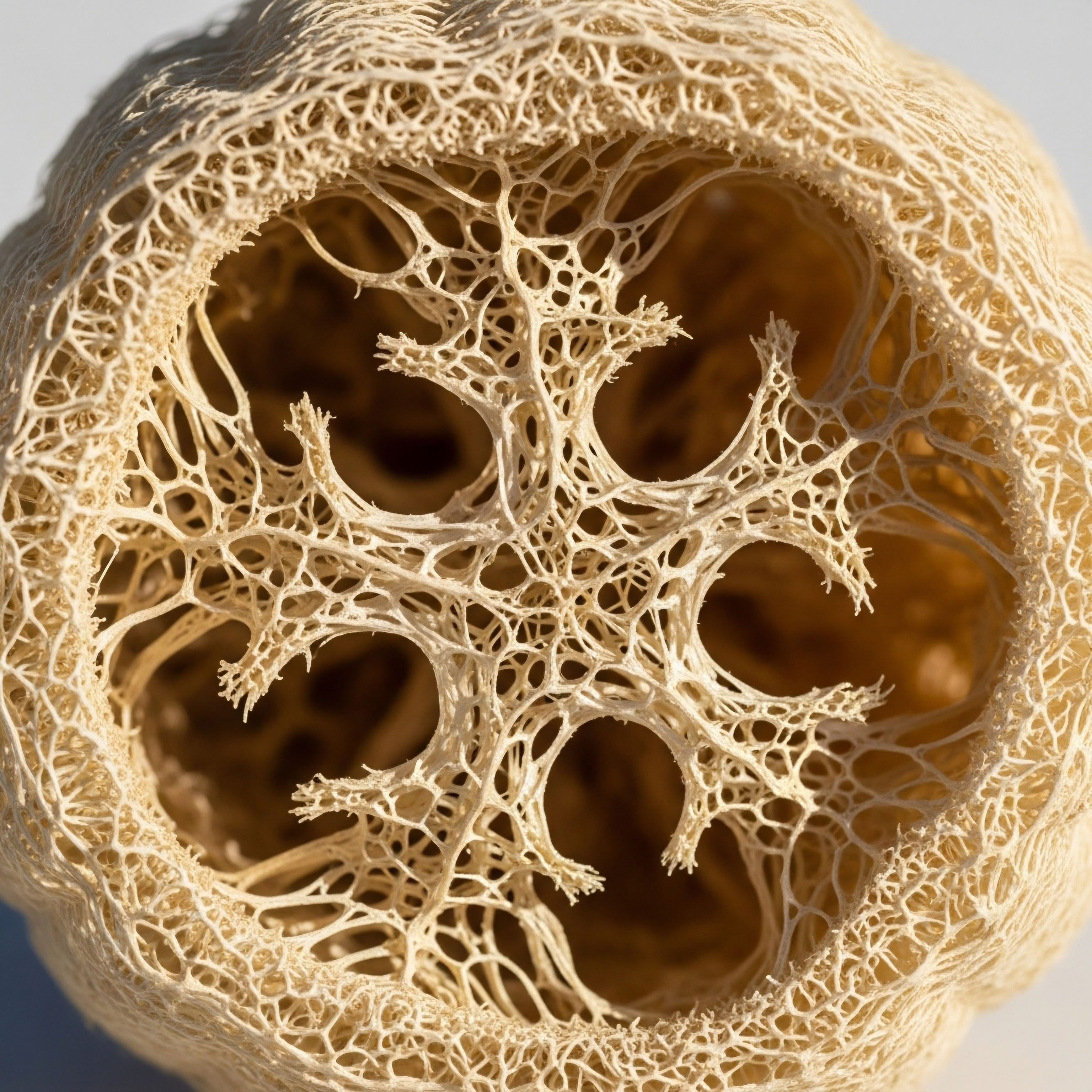

Fundamentals
The decision to discontinue a hormonal protocol marks a significant transition point in your personal health architecture. You may be feeling a mix of uncertainty and anticipation, observing your body for signs of change. These feelings are a valid and expected part of the process.
Your body, having adapted to a state of external hormonal support, is now beginning a process of recalibration. This phase is an active dialogue between your internal systems, a return to self-regulation. Understanding the principles of this recalibration is the first step toward supporting your body’s innate capacity for balance and reclaiming a state of metabolic vitality.
At the center of this entire process is a sophisticated communication network known as the Hypothalamic-Pituitary-Gonadal (HPG) axis. Think of this as the primary command and control system for your reproductive and metabolic hormones. It is a finely tuned feedback loop, constantly monitoring and adjusting hormonal levels to maintain a state of dynamic equilibrium.
The hypothalamus, a small region at the base of your brain, acts as the mission commander. It secretes Gonadotropin-Releasing Hormone (GnRH) in precise, rhythmic pulses. These pulses are signals sent to the pituitary gland, the field commander, instructing it to release two other critical hormones ∞ Luteinizing Hormone (LH) and Follicle-Stimulating Hormone (FSH).
The body’s journey off hormonal support is a guided recalibration of its internal communication systems, not an abrupt cessation of function.

The Key Messengers and Their Roles
LH and FSH travel through the bloodstream to the gonads (the testes in men and ovaries in women), which function as the specialized production facilities. Here, they deliver their instructions. In men, LH stimulates the Leydig cells in the testes to produce testosterone. FSH, along with testosterone, is essential for sperm production.
In women, FSH stimulates the growth of ovarian follicles, which in turn produce estrogen. A surge in LH then triggers ovulation and the production of progesterone. These end-product hormones, testosterone and estrogen, do far more than govern reproductive function. They are powerful metabolic regulators that influence muscle mass, fat distribution, bone density, insulin sensitivity, and even cognitive function.
The elegance of the HPG axis lies in its self-regulating nature. The hypothalamus and pituitary are exquisitely sensitive to the levels of testosterone and estrogen circulating in the blood. When these hormone levels rise, they send a signal back to the hypothalamus and pituitary to slow down the release of GnRH, LH, and FSH.
This is called a negative feedback loop. It works much like a thermostat in your home ∞ when the temperature reaches the set point, the furnace shuts off. When it drops, the furnace kicks back on. During hormonal support protocols, the presence of external hormones keeps this system in a suppressed state.
The “thermostat” constantly reads that the levels are sufficient, so the internal “furnace” remains off. Discontinuation removes this external signal, and the system must learn to fire up on its own again.

Metabolic Consequences of Hormonal Shifts
When the HPG axis is suppressed, and then external support is removed, the body enters a temporary state of hormonal deficiency. The time it takes for the natural production to resume can vary significantly from person to person. During this recalibration window, the absence of optimal testosterone and estrogen levels can have direct metabolic consequences.
You might experience changes in body composition, such as a decrease in lean muscle mass and an increase in fat storage, particularly around the abdomen. Your energy levels may fluctuate, and your body’s ability to manage blood sugar can be altered, potentially reducing insulin sensitivity.
These are not signs of failure; they are physiological responses to a changing internal environment. They are data points, signaling that your body is in a state of transition and requires targeted support to navigate the path back to metabolic efficiency.


Intermediate
Navigating the period after discontinuing hormonal support requires a strategic approach designed to encourage the reawakening of the body’s endogenous endocrine machinery. The goal is to shorten the transitional period of low hormone symptoms and guide the Hypothalamic-Pituitary-Gonadal (HPG) axis back to its inherent, pulsatile rhythm. This is accomplished through specific clinical protocols that work at different levels of the axis, combined with foundational lifestyle strategies that create a permissive environment for recovery.

Protocols for HPG Axis Recalibration
A structured recalibration protocol, often referred to as a “restart,” utilizes specific pharmaceutical agents to stimulate the dormant components of the HPG axis. These protocols are carefully timed based on the type and duration of the hormonal support that was discontinued. The core objective is to re-establish the signaling cascade from the brain to the gonads.

Selective Estrogen Receptor Modulators (SERMs)
SERMs are a class of compounds that play a central role in HPG axis recalibration. They function by binding to estrogen receptors in the hypothalamus and pituitary gland. By occupying these receptors, they block circulating estrogen from exerting its normal negative feedback.
The brain, perceiving a low estrogen state, responds by increasing its output of GnRH, which in turn stimulates the pituitary to produce more LH and FSH. This surge in gonadotropins signals the testes or ovaries to resume their own hormone production.
- Clomiphene Citrate ∞ This SERM is highly effective at stimulating the pituitary to release LH and FSH. It acts as an estrogen receptor antagonist in the hypothalamus, effectively taking the “brakes” off the system and promoting a robust increase in gonadotropin signaling to restart endogenous testosterone production.
- Tamoxifen Citrate ∞ Similar to clomiphene, tamoxifen also blocks estrogen receptors in the pituitary. It is often used to mitigate gynecomastia but also serves to increase LH and FSH output, contributing to the restoration of the HPG axis. Some protocols may use it in conjunction with or following a course of clomiphene.

Aromatase Inhibitors (AIs)
During a restart protocol, as endogenous testosterone levels begin to rise, so too will the conversion of that testosterone into estrogen via the aromatase enzyme. While some estrogen is vital for male health, excessive levels can be counterproductive, suppressing the HPG axis and causing side effects.
Anastrozole is an AI that temporarily reduces the activity of the aromatase enzyme, helping to maintain a balanced testosterone-to-estrogen ratio and preventing the newly stimulated HPG axis from being dampened by high estrogen feedback.

Upstream Signaling with Gonadorelin
Instead of only blocking negative feedback at the pituitary, it is also possible to stimulate the system from the very top. Gonadorelin is a synthetic version of GnRH. When administered in a pulsatile fashion, it directly stimulates the pituitary gland to release LH and FSH.
This approach essentially mimics the body’s natural signaling pattern from the hypothalamus. It is particularly useful for confirming that the pituitary gland is responsive and can be a foundational part of a comprehensive restart protocol, ensuring the entire axis is being activated from the top down.
A successful recalibration protocol is a multi-pronged strategy, addressing signaling at every level of the hormonal axis.
What is the most effective sequence for these interventions? The specific structure of a protocol depends on individual factors, including the duration of previous therapy and baseline health markers. A common approach involves initiating treatment with a SERM like clomiphene to stimulate the pituitary, while carefully managing estrogen with an AI like anastrozole.
Gonadorelin might be used initially to prime the pituitary. The duration is typically several weeks, followed by a tapering period and careful monitoring of blood work to confirm the axis has regained independent function.
| Agent | Mechanism of Action | Primary Role in Protocol |
|---|---|---|
| Clomiphene Citrate | SERM; blocks estrogen receptors in the hypothalamus/pituitary. | Stimulates LH and FSH release to restart gonadal function. |
| Tamoxifen Citrate | SERM; blocks estrogen receptors, primarily in pituitary and breast tissue. | Stimulates gonadotropins and manages potential gynecomastia. |
| Anastrozole | Aromatase Inhibitor; reduces the conversion of testosterone to estrogen. | Controls estrogen levels to prevent negative feedback suppression. |
| Gonadorelin | GnRH analogue; directly stimulates the pituitary gland. | Initiates the signaling cascade from the top of the axis. |

Supporting Metabolic Function with Peptide Therapy
While the HPG axis is recalibrating, metabolic function can be directly supported through other pathways. This is where growth hormone (GH) secretagogues become valuable adjuncts. These are peptides that stimulate the pituitary gland to release its own stores of growth hormone. A healthier GH profile is directly linked to improved metabolic outcomes, including increased lipolysis (fat burning), enhanced muscle protein synthesis, and better sleep quality, all of which can be compromised during the transition phase.
- Sermorelin ∞ A GHRH analogue, Sermorelin mimics the body’s natural growth hormone-releasing hormone, causing a gentle, pulsatile release of GH from the pituitary.
- Ipamorelin / CJC-1295 ∞ This popular combination provides a potent, synergistic effect. CJC-1295 is a GHRH analogue with a longer duration of action, providing a steady elevation in GH levels. Ipamorelin is a selective GHRP that stimulates a strong pulse of GH without significantly affecting other hormones like cortisol. Together, they promote a robust and sustained increase in natural GH output.
Using these peptides during the recalibration phase can help counteract the potential for fat gain and muscle loss, support energy levels, and improve recovery, effectively bridging the metabolic gap while your primary sex hormones come back online.


Academic
The restoration of metabolic homeostasis following the cessation of exogenous hormonal therapy is fundamentally dependent on the successful re-establishment of endogenous neuroendocrine pulsatility. The central event in this process is the reactivation of the Gonadotropin-Releasing Hormone (GnRH) pulse generator within the hypothalamus.
This intricate neural network, once freed from the suppressive influence of supraphysiological hormone levels, must resume its characteristic, high-frequency, low-amplitude episodic secretions to drive pituitary and gonadal function. A deeper examination of the cellular and molecular mechanisms governing this restart provides a sophisticated framework for understanding and optimizing clinical support protocols.

The KNDy Neuron as the GnRH Pulse Generator
Contemporary neuroendocrinology has identified a specific population of neurons in the arcuate nucleus of the hypothalamus as the likely origin of the GnRH pulse generator. These are the kisspeptin/neurokinin B/dynorphin (KNDy) neurons. This elegant system operates through a coordinated interplay of its neuropeptide co-transmitters:
- Neurokinin B (NKB) ∞ This peptide acts as an accelerator. It auto-stimulates the KNDy neurons themselves through its receptor, Tacr3, initiating a synchronized firing event across the neural population.
- Kisspeptin ∞ Following NKB-induced activation, KNDy neurons release kisspeptin. Kisspeptin is the primary secretagogue for GnRH, binding to its receptor (Kiss1R) on GnRH neurons and triggering a pulse of GnRH release into the hypophyseal portal system.
- Dynorphin ∞ This peptide acts as a brake. As the firing event peaks, dynorphin is co-released and acts on kappa opioid receptors (KOR) on the KNDy neurons, terminating the synchronized activity and creating the space before the next pulse begins.
Exogenous testosterone administration suppresses this entire system. Testosterone, both directly and through its aromatization to estradiol, enhances the inhibitory tone on the GnRH pulse generator. This chronic suppression leads to a functional dormancy of the KNDy neuronal network. The core challenge of a “restart” protocol is to overcome this induced quiescence.

Molecular Intervention with Selective Estrogen Receptor Modulators
Selective Estrogen Receptor Modulators (SERMs) like clomiphene and tamoxifen are the primary pharmacological tools for restarting the HPG axis. Their efficacy can be understood at the molecular level. Estradiol exerts its powerful negative feedback primarily through the estrogen receptor alpha (ERα) subtype, which is highly expressed in KNDy neurons and other hypothalamic sites.
Clomiphene citrate is a non-steroidal triphenylethylene derivative that acts as an ERα antagonist in the hypothalamus. By competitively binding to ERα, it prevents estradiol from activating the receptor’s transcriptional silencing pathways. This blockade effectively removes the primary inhibitory signal on the KNDy network.
The removal of this estrogen-mediated brake allows the inherent stimulatory drive of NKB to re-initiate the pulsatile firing of the KNDy neurons. The subsequent release of kisspeptin then drives the GnRH neurons, and the entire HPG axis cascade is reactivated. Tamoxifen functions through a similar antagonistic mechanism at the hypothalamic-pituitary level.
The reactivation of the HPG axis is a neuroplastic event, centered on disinhibiting the KNDy neuronal network to restore endogenous GnRH pulsatility.
How does this impact metabolic health from a regulatory standpoint? The re-establishment of pulsatile LH and subsequent endogenous testosterone production is paramount. Testosterone is a key determinant of insulin sensitivity, glucose uptake in skeletal muscle, and the regulation of visceral adipose tissue.
The period of hypogonadism during an unassisted recovery is associated with a downregulation of androgen receptor expression in target tissues and a shift toward a pro-inflammatory, insulin-resistant state. A clinically guided restart protocol that rapidly restores endogenous testosterone production can mitigate these adverse metabolic shifts.

System-Wide Metabolic Recalibration
The conversation extends beyond the HPG axis. The transition period represents a state of systemic metabolic stress. Supporting other endocrine axes is therefore a logical strategy. The use of growth hormone secretagogues like the GHRH-analog CJC-1295 and the ghrelin-receptor agonist Ipamorelin addresses the metabolic milieu directly. Growth hormone and its primary mediator, Insulin-like Growth Factor 1 (IGF-1), have profound effects on body composition and substrate metabolism.
What are the specific metabolic benefits during this transition? Increased GH/IGF-1 signaling promotes lipolysis, enhances fatty acid oxidation, and has a protein-anabolic effect, preserving lean body mass. This is particularly critical when androgen levels are sub-optimal. The table below outlines the distinct yet complementary roles of HPG axis restart agents and metabolic support peptides.
| Therapeutic Agent | Primary Target | Molecular Action | Systemic Outcome |
|---|---|---|---|
| Clomiphene Citrate | Hypothalamic ERα | Antagonizes estradiol-mediated negative feedback on KNDy neurons. | Restores GnRH/LH pulsatility and endogenous testosterone production. |
| Anastrozole | Aromatase Enzyme | Competitively inhibits the conversion of androgens to estrogens. | Prevents excessive estrogenic suppression of the recovering HPG axis. |
| CJC-1295 / Ipamorelin | Pituitary GHRH-R & Ghrelin-R | Stimulates endogenous pulsatile release of Growth Hormone. | Improves insulin sensitivity, promotes lipolysis, and preserves lean mass. |
Ultimately, supporting metabolic health after discontinuing hormonal protocols is a two-fold process. It involves a direct, pharmacologically-guided reactivation of the core neuroendocrine pulse generator. It also involves providing systemic metabolic support to bridge the transitional gap, preserving physiological function while the body’s own regulatory systems are brought back to a state of self-sufficient, dynamic equilibrium.

References
- Lykhonosov, M. P. “Peculiarity of recovery of the hypothalamic-pituitary-gonadal (hpg) axis, in men after using androgenic anabolic steroids.” Problems of Endocrinology, vol. 66, no. 4, 2020, pp. 57-64.
- Rastrelli, Giulia, et al. “Recovery of Male Reproductive Endocrine Function Following Prolonged Injectable Testosterone Undecanoate Treatment.” The Journal of Clinical Endocrinology & Metabolism, vol. 106, no. 8, 2021, pp. e3094-e3105.
- Defy Medical. “HPTA Restart Protocol for Discontinuing TRT.” Defy Medical, 2021.
- Kim, Hyun-Jin, et al. “Clomiphene Citrate Treatment as an Alternative Therapeutic Approach for Male Hypogonadism ∞ Mechanisms and Clinical Implications.” Journal of Clinical Medicine, vol. 12, no. 15, 2023, p. 5047.
- Le, Brian, and Jason M. Hedges. “The role of clomiphene citrate in late onset male hypogonadism.” Translational Andrology and Urology, vol. 7, no. 3, 2018, pp. 444-451.
- Vermeulen, A. and F. Comhaire. “Hormonal effects of an antiestrogen, tamoxifen, in normal and oligospermic men.” Fertility and Sterility, vol. 29, no. 3, 1978, pp. 320-327.
- Ghuman, Simi, et al. “Tamoxifen to treat male pubertal gynaecomastia.” BMJ Case Reports, vol. 14, no. 1, 2021, p. e239113.
- Sigalos, J. T. and W. W. T. Z. a. A. W. Pastuszak. “Sermorelin vs. CJC-1295 vs. Ipamorelin ∞ Comparing Popular Growth Hormone Peptides.” Invigor Medical, 2023.
- Herbison, Allan E. “Neuroendocrine control of gonadotropin-releasing hormone ∞ Pulsatile and surge modes of secretion.” Journal of Neuroendocrinology, vol. 34, no. 3, 2022, p. e13094.
- Ciechanowska, M. et al. “Neuroendocrine regulation of GnRH release and expression of GnRH and GnRH receptor genes in the hypothalamus-pituitary unit in domestic ruminants.” Reproductive Biology, vol. 10, no. 2, 2010, pp. 85-124.

Reflection
You have now explored the intricate biological architecture that governs your hormonal and metabolic systems. This knowledge is a powerful tool. It transforms the experience of discontinuing a protocol from a period of passive waiting into a phase of active, informed participation in your own health. The sensations you feel, the changes you observe in your body, are no longer mysterious events. They are part of a predictable, understandable process of recalibration.
This understanding shifts the focus from a simple endpoint to a dynamic continuum. The journey is one of restoring communication within your body, of supporting its innate intelligence. Each choice you make regarding nutrition, exercise, sleep, and targeted clinical support becomes a direct input into this system.
What does this recalibration process mean for you personally? How can you apply this systems-based perspective to your own unique physiology? The path forward is one of partnership with your body, guided by data and a profound respect for its capacity to find balance.



